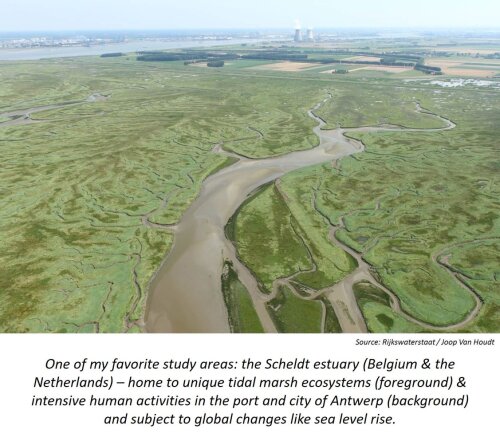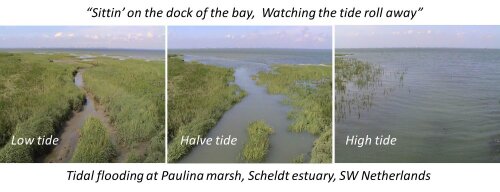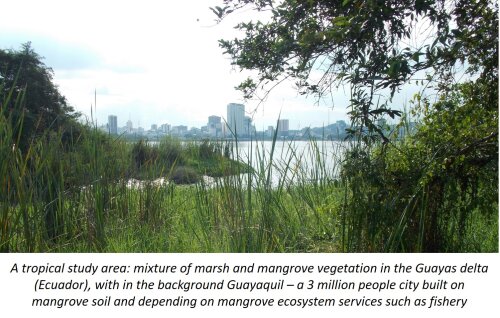Stijn Temmerman


I am a Geographer studying impacts of global change on coasts and river landscapes, and how ecosystems and human society can mitigate and adapt to global change. Coasts and river landscapes are hotspots of biodiversity and human activity, that are impacted by sea level rise, changing storm and rainfall patterns, floods and erosion risks, human landscape engineering, etc. Living myself just above sea level, I like to contribute to science-based solutions to mitigate global and local impacts on coastal and riverine socio-ecological systems. This involves studies on nature-based mitigation of climate impacts, such as flood risk reduction by marshes and mangroves; climate change mitigation by carbon storage in tidal wetlands; resilience of coastal ecosystems to sea level rise, storms and human impacts. (Read more below)

Schuerch, M., Spencer, T., Temmerman, S., Kirwan, M. L., Wolff, C., Lincke, D., McOwen, C. J., Pickering, M. D., Reef, R., Vafeidis, A. T., Hinkel, J., Nicholls, R. J., and Brown, S., 2018, Future response of global coastal wetlands to sea-level rise: Nature, v. 56, p. 231-234.
Temmerman, S., Meire, P., Bouma, T. J., Herman, P. M. J., Ysebaert, T., and De Vriend, H. J., 2013, Ecosystem-based coastal defence in the face of global change: Nature, v. 504, p. 79-83.
Temmerman, S., and Kirwan, M. L., 2015, Building land with a rising sea: Science, v. 349, no. 6248, p. 588-589.
Kirwan, M. L., Temmerman, S., Skeehan, E. E., Guntenspergen, G. R., and Fagherazzi, S., 2016, Overestimation of marsh vulnerability to sea level rise: Nature Climate Change, v. 6, p. 253-260.
Van Coppenolle, R., Schwarz, C., and Temmerman, S., 2018, Contribution of mangroves and salt marshes to nature-based mitigation of coastal flood risks in major deltas of the world: Estuaries and Coasts, v. 41, no. 6, p. 1699-1711.
Schwarz, C., Gourgue, O., Van Belzen, J., Zhu, Z., Bouma, T. J., Van de Koppel, J., Ruessink, G., Claude, N., and Temmerman, S., 2018, Self-organization of a biogeomorphic landscape controlled by plant life-history traits: Nature Geoscience, v. 11, p. 672–677.
For a complete publication list, please see here.
My fascination for nature and more specifically the dynamics of rivers and coasts started at a young age, spending part of my childhood “sitting on the dock of the bay, watching the tide roll away” – as in the song of Otis Redding. I grew up along the Schelde estuary, a tidal river in Belgium. Inspired by my family living in close connection to the river, I got fascinated by the river's dynamic nature: the tide - rolling up and down the river twice a day - determines the never ending rhythm of life for people, animals and plants living along this tidal river. Rivers can be a great source of welfare to humans - for example, my grandparents lived from ship building. But at the same time rivers can generate large risks to people - for instance, my parents' house flooded during several river flood events. On the other hand, human activities may seriously impact the sustainability of river ecosystems - from my childhood, I remember the terrible smelling of river pollution, but today the situation has luckily improved. Or how my family stories illustrate the delicate balance between human exploitation and sustainability of natural resources.

This fascination for human-environment interactions inspired me to study Physical Geography (1995-1999) and to obtain a PhD degree on tidal marsh sedimentation in response to sea level rise (2000-2003) at the University of Leuven (Belgium). In 2004-2005 I worked as a post-doctoral researcher (with an EU Marie Currie grant) at the Netherlands Institute for Sea Research, on bio-geomorphic landscape dynamics of tidal marshes in response to environmental forcing factors. Since 2005 I’m a professor at the University of Antwerp (Belgium), where I’m teaching courses in Earth Sciences, and working on research projects on River, Estuarine and Coastal system dynamics, and how these systems interact with global and local environmental changes and human impacts.
I'm leading a team of PhD and Master students and post-doc researchers, and am always looking for highly motivated people to join! On top of this page is an aerial picture of one of our favorite study areas, the marshes of "Saeftinghe" in the SW Netherlands - one of the largest remaining tidal marsh areas in Europe. Recently we also work in tropical mangrove forests such as shown in the picture below.
We study tidal wetlands (marshes and mangroves), which are among the most dynamic landscapes on Earth. Located at the edge of land and sea, the daily tidal currents and waves sculpt the landscape, eroding channels in one place and depositing sand bars and mud on other places. Plants and animals live here in extreme conditions and need to adapt to the regular flooding, resulting in unique ecosystems with highly specialized species.

Tidal wetlands also provide so-called ecosystem services - that are benefits contributing to the wellfare of human societies. Indeed, large centres of human population have developed in estuaries and deltas of large rivers, including mega cities like New York, Shanghai, London, etc. and countries like the Netherlands and Bangladesh. People living along coasts, river deltas and estuaries depend on the valuable ecosystem services, such as the contribution of tidal wetlands to fisheries production, to mitigation of the impacts of flood risks, regulation of a healthy water quality, and climate regulation by removal of CO2 from the atmosphere. But human impacts, such as sea level rise due to climate warming, pollution and river and coastal engineering works, are challenging the sustainability of deltas, estuaries, and their tidal wetlands. Therefore, scientific knowledge on tidal wetland functioning and how that depends on the interactions between physical, chemical, biological and anthropogenic processes, is of key importance for the sustainable managment of rivers, estuaries and coastal zones, and the safegarding of their valuable ecosystem services to human society.
Together with colleagues of the Ecosystem Management research group, we study the dynamics of coastal marshes, estuaries and rivers, in support of their sustainable management. We focus on interactions between flow hydrodynamics (tides and waves), sediment transport (sand and mud erosion and deposition), geomorphological dynamics (such as channel formation and land accretion with sea level rise) and vegetation dynamics (such as colonization and die-back), and how these eco-geomorphic feedbacks control the response of (tidal) river systems to global change and human impacts. Particular research questions include:
* How do tidal wetlands, such as marshes and mangroves, respond to sea level rise in the past, present-day, and future? Under which conditions can these wetlands accumulate enough sediments and build up their elevations with rising sea level? Or in which situations do they fail to build up, and how does the wetland vegetation respond then to increasing tidal flooding and will it eventually die-off? Is there potential for recovery after marsh loss?
* How much can tidal wetlands help human socities to adapt to and mitigate global change? Can they contribute to nature-based solutions to increasing flood risks? For example, how effective are marshes as buffers against sea level rise, extreme storms, storm surges, wave impacts, and shoreline erosion? And how effective are they in assimilating atmospheric CO2 into soil carbon and as such in mitigating the effects of atmospheric CO2 on climate warming?
* What determines the formation of new marshes on originally bare sand and mud flats? And vice versa, the degradation of established marshes? How is colonization of pioneer vegetation controlled by bio-physical interactions between plant growth (seedling survival, clonal expansion rates, die-off), flow hydrodynamics (tidal currents, waves), and geomorphic dynamics (erosion, sedimentation)? And can we use this knowledge to restore or develop new marshes?
* How can we restore tidal wetlands in situations where wetlands were historically lost by conversion into human land use? How can the wetland ecosystems and their functioning effectively be restored ?
* A complementary line of research is on small, non-tidal lowland rivers, where the river bed is grown by aquatic plants. How do aquatic plants interact with the river flow of water, sediments and nutrients? How do these interactions lead to bio-geomorphic self-organisation of spatial vegetation patterns and geomorphic patterns on the river bed? What is the impact of aquatic plants on increased hydraulic friction, increasing river water levels and increasing flood risks? What is the expected response of the river ecosystem to changing discharge regimes induced by climate and land use change?
Methods used to answer these research questions include experiments in the field and in laboratory flumes, field measurements, remote sensing, and computer modelling. I work with several PhD and Master students and post-docs, and in collaboration with international experts in ecology, geo-science and engineering, with main field sites in Europe and North and South America.